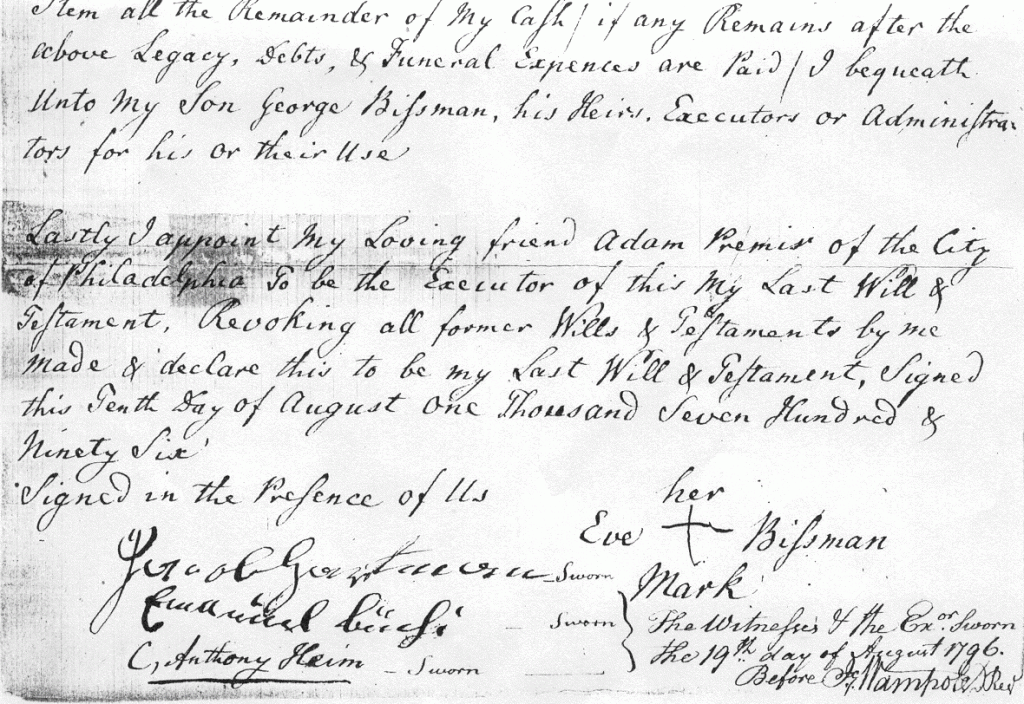The Behe Family in America
Emanuel Behe, his wife Mary Ann, and at least three children arrived in America in 1790. Mary Ann was expecting another child, Mathias, who would become the first American born Behe. According to the McMullen book, Emanuel’s sister Mary Ann travelled with them. Most immigrants had to scrimp and save for a long period of time to afford the passage, and many arrived with large debts and possibly became indentured servants. The family financial situation, their reason for coming, or if they had contacts in America before leaving, is unknown.
The Voyage
Prior to securing passage on a ship, many immigrants faced a difficult trip just getting to the port. For Emanuel and family this likely meant a trip both by river boat and overland, possibly to the Dutch port of Rotterdam. Sailings were not scheduled on a timely basis, and the family may have had to stay in the port town for a period. Immigrant voyages in the 18th century could be extremely harsh. The trips took 2-4 months, depending on weather conditions. Passengers had little space or privacy, disease was a major issue, and storms would make the passage miserable. Food and water, especially on a longer voyage, were of poor quality. Below is a description written by an 18th century German immigrant to Pennsylvania.
“during the voyage there is on board these ships terrible misery, stench, fumes, horror, vomiting, many kinds of seasickness, fever, dysentery, headache, heat, constipation, boils, scurvy, cancer, mouth rot, and the like, all of which come from old and sharply-salted food and meat, also from very bad and foul water, so that many die miserably. Add to this want of provisions, hunger, thirst, frost, heat, dampness, anxiety, want, afflictions and lamentations, together with other trouble, as e.g., the lice abound so frightfully, especially on sick people, that they can be scraped off the body. The misery reaches a climax when a gale rages for two or three nights and days, so that everyone believes that the ship will go to the bottom with all human beings on board. In such a visitation the people cry and pray most piteously. No one can have an idea of the sufferings which women in confinement have to bear with their innocent children on board these ships. Few of this class escape with their lives; many a mother is cast into the water with her child as soon as she is dead. One day, just as we had a heavy gale, a woman in our ship, who was to give birth and could not give birth under the circumstances, was pushed through a loophole (porthole) in the ship and dropped into the sea, because she was far in the rear of the ship and could not be brought forward. Children from one to seven years rarely survive the voyage; and many a time parents are compelled to see their children miserably suffer and die from hunger, thirst, and sickness, and then to see them cast into the water. I witnessed such misery in no less than thirty-two children in our ship, all of whom were thrown into the sea. The parents grieve all the more since their children find no resting place in the earth, but are devoured by the monsters of the sea. It is a notable fact that children who have not yet had the measles or smallpox generally get them on board the ship, and mostly die of them.”
While all voyages were probably not like this, one can imagine the arduous journey. This would have been all the more difficult with young children, one only two years of age, and an expectant mother. Add to this the uncertainty of arriving in a new country and the realization that you would almost certainly never see your homeland or family again. Such was the experience of our immigrant ancestors.
Arrival in America
The McMullen book states that the family arrived in Baltimore, though there is no known documentation of their arrival. We do know that Anthony was born in Germany in 1788, and Mathias was born in the U.S. in May of 1790, so the arrival was between those dates. The earliest known document showing Emanuel in the U.S. is as a witness on a Last Will in Philadelphia on August 10, 1796. Whether he was living in Philadelphia, or travelled there for this or some other reason, is unknown.

Emanuel Behe as a witness on a Last Will in Philadelphia on August 10, 1796. His signature, in German, is the second from the bottom on the left.
The next known documentation is his naturalization, which occurred in Huntington County, Pa., in 1802. There are two items of note on the document. First, it confirms that Emanuel was from the Province of Alsace. His children, on later census records, show their place of birth as Baden and/or Germany. The first of these were born in 1780, so it can be surmised that Emanuel left Alsace for Baden prior to that time. The other item of note was how the court scribe spelled his name. In the McMullen book it states the name may have been Peche, which seems to have originated with this document.
In 1802 the family is living in Loretto, with the first births recorded there in the St. Michaels Church records. Emanuel and family appear in the 1810 U.S. census and the 1810 county property tax assessments. His occupation is listed as manufacturing; a gunsmith and tinner. In addition to the children born in Europe (Joseph, Susannah, and Anthony), there were two additional sons, Mathias (b 1790) and Conrad (b 1796), and daughters Mary and Maria (dates of birth unknown). The county assessment records from 1810-1813 also lists a John Behe, occupation distiller. John disappears from the tax rolls in 1813. I suspect that this is the eldest son of Joseph, who by this time was living in Emmitsburg. There is a record of Joseph also being involved in the distilling business. This is not known for sure, but it would appear to be his son, Emanuel’s grandson.
This was the first generation of the Behe family in America.
Loretto and Father Gallitzen

Father Demetrius Gallitzin
As noted, there is no documented evidence showing the Behe family movements from arrival in 1790 until they are living in Loretto in 1802. This peaceful little town was founded in 1799 by Father Demetrius Gallitzin, the ‘Apostle of the Alleghenies’. Gallitzin was a fascinating character. He was born in 1770 in The Hague, a child of Russian nobility whose father was the Russian ambassador to the Netherlands. His mother was a German countess, who brought Demetrius into the Catholic faith as a teen. In 1792 he travelled to the States as a part of his education. He decided to enter the priesthood, and was ordained in 1795. He was stationed at parishes in Maryland and in Adams County, Pa. From there he was summoned to attend to a sick woman at McGuire’s Settlement in western Pennsylvania.
This small settlement was founded by Captain Michael McGuire, who had served in the Revolutionary War and moved to this wilderness in 1788. After his death in 1793, he bequeathed his property to the church. Gallitzin saw this area as holding great promise, and established Loretto, named after the sacred site in Italy. He spent his fortune purchasing land, which was either given or sold at very low rates to parishioners willing to move there. A small chapel was built, with an adjoining living area for Father Gallitzin, and the first mass was celebrated on Christmas night 1799.
How or why the Behe family ended up in Loretto is not known. It is likely they made the acquaintance of Father Gallitzin or heard of the settlement through other German Catholic families. The family is said to have lived for a time at Conewego, Pa, where Gallitzin served. We can surmise that the family somehow knew of the attractive land purchase available in Loretto and moved there.
In the book, Americans of Gentle Birth, it is claimed that Emanuel knew and was close friends with Gallitzin in Strasbourg, Alsace, and that he followed him to the U.S. This seems unlikely. First of all, Emanuel arrived in 1790 and as such could not have followed Gallitzin, who arrived in 1792. Also, I have seen no evidence that Gallitzin ever was in Strasbourg. He was not a priest at that time, so is doubtful they met through the church. And it seems unlikely that a member of the nobility would be close friends with a tinner.

